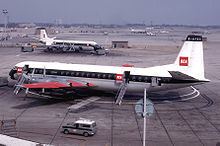Site Aarsele, Belgium Crew 8 Survivors 0 Operator British European Airways Survivor 0 Locations Aarsele, Belgium | Passengers 55 Injuries (non-fatal) 1 (minor, ground) Date 2 October 1971 Total fatalities 63 (all) Passenger count 55 | |
 | ||
Summary Explosive decompression, leading to structural failure and loss of control Similar 1971 Indian Ocean Vi, 1971 January 22 Surgut Ae, Hughes Airwest Flight 706, Toa Domestic Airlines Fl, Aviogenex Flight 130 | ||
British European Airways Flight 706 was a scheduled flight from London-Heathrow Airport (LHR) to Salzburg-W. A. Mozart Airport (SZG), by Vickers Vanguard G-APEC, on 2 October 1971. Whilst en route at 19,000 ft (5,791 m), 35 minutes after takeoff, the rear cabin pressure bulkhead failed. The resulting depressurisation of the tail section caused the surfaces of the tailplanes to separate, weakening them to the point that they broke off. Without a horizontal stabiliser the aircraft entered an uncontrollable dive. The aircraft crashed near Aarsele, Belgium, killing all 63 passengers and crew on impact. A piece of debris from the aircraft struck a passing car, causing minor injuries to one of its occupants.
Investigators, in attempting to determine the cause of the accident, found corrosion in the lower part of the rear pressure bulkhead underneath plating that was bonded to the structure. The bulkhead had been eaten away. Fluid contamination, perhaps from the lavatory, was thought to have been the root cause for the corrosion. The corrosion was not detectable by then-current inspection techniques. The Belgian Civil Aeronautics Administration wrote the report and the British Air Accidents Investigation Branch had accredited personnel assisting the investigation.
Two notable fatalities among the passengers were the British hat designer Otto Lucas and an Austrian academic, René Marcic.
